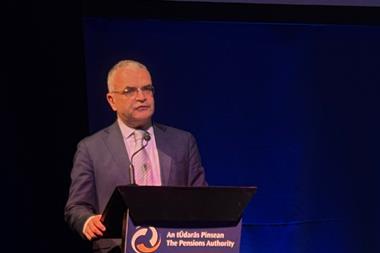Trustees in Ireland are striving to de-risk defined benefit (DB) schemes as slowly as possible and are doing so only begrudgingly, despite regulation requiring a shift into liability-matching assets, according to the head of the Pensions Board.
Brendan Kennedy also raised concerns about the use of contingent assets as part of DB funding proposals and said schemes should prepare for a regulator looking to engage with them on issues of governance, as he revealed that the number of funds was expected to fall by one-quarter by the end of the year.
Addressing the Irish Association of Pension Funds (IAPF) annual benefits conference in Dublin this week, the Pensions Board’s chief executive both praised and admonished those running the country’s DB funds.
He welcomed funds, having completed their funding proposals following the 30 June deadline, granting themselves “some wiggle room” to meet minimum funding and risk-reserve requirements prior to 2023 by applying more stringent standards during in-house calculations than in submitted proposals – a move “very much to be welcomed”.
“Clearly, what that means is the schemes have built themselves some buffers, and they will have built in some flexibility as they are faced by possible investment losses over the coming 10 years,” he said.
“We all know that, whatever else happens over the next 10 years, it won’t be a straight line, that there will be gains and losses over that time.”
However, he said the story was different when it came to trustees complying with revised funding standard demands that require the exposure to fixed income and cash to mirror the expected pensioner population in a decade’s time.
Kennedy stressed that all submitted funding proposals complied with the regulation, “but it is very clear from those funding proposals that they are doing this de-risking begrudgingly and at the minimum rate possible”.
He cited one scheme’s proposal to hold matching assets within less than 1% of its pensioner population by 2023, noting that there was “clearly” a difference of opinion between the regulator, trustees and their advisers on how to invest.
The chief executive also expressed some concern about the use of contingent assets in submitted funding proposals.
He said a limited number of funding proposals had made allowances for contingent assets to be put in place during its 10-year lifetime, but that the approach was unlikely to be acceptable.
“We need more certainty in the funding proposals before we approve them,” he said.
He also signalled a more proactive approach on the part of the regulator as the number of DB funds declined, revealing that the Board’s own predictions were for around 750 active funds at the end of the year compared with nearly 1,000 in December 2011.
Kennedy further said that the Board would publish a guide on best practice in DB governance before Christmas.
“We look forward to liaising with the IAPF to discuss these,” he said, “but our objective will be to move towards a basis for engagement with the remaining defined benefit schemes, and we will use our best practice as basis for that engagement.”
He said the DB funds that remained after 13 years of market turbulence “can only be described as damaged”.
He said the Board’s concern, despite all the regulatory changes in recent years, remained that the outcome for the industry would be no different if events surrounding the more recent financial crises were to repeat themselves.
“And I am not convinced it would be,” he said, “and that is what is driving us to further work on defined benefit governance.”















